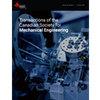不同雷诺数下非圆形湍流射流速度与扩散特性的数值研究
IF 1
4区 工程技术
Q4 ENGINEERING, MECHANICAL
Transactions of The Canadian Society for Mechanical Engineering
Pub Date : 2023-11-03
DOI:10.1139/tcsme-2023-0028
引用次数: 0
摘要
对非圆形湍流射流的流场特性进行了数值研究。采用Ansys Fluent软件中的k-ε湍流模型进行了稳态数值模拟。利用热线风速仪沿射流中心线收集速度数据进行速度验证。射流出口雷诺数从200到5000不等,包括层流和湍流两种状态。研究了平均流场特性,如平均速度、湍流强度、速度衰减和半射流展宽。模拟结果表明,平均速度剖面衰减呈现出普遍的衰减模式,横向速度分布在近场呈顶帽状。在下游较远的距离上,它明显地变成了峰形和抛物线形。湍流强度分布表明,剪切层在射流出口附近开始生长,随着雷诺数的增加,夹带作用变得越来越强。随着雷诺数的增加,潜在核心区增大。射流扩散宽度随射流出口雷诺数的增加呈线性增长。数值计算结果与实测实验结果吻合较好,与已发表的数据吻合较好。本文章由计算机程序翻译,如有差异,请以英文原文为准。
NUMERICAL INVESTIGATION OF VELOCITY AND SPREADING CHARACTERISTICS OF NON-CIRCULAR TURBULENT JETS AT DIFFERENT REYNOLDS NUMBERS
The flow field characteristics of non-circular turbulent jets are investigated numerically. A steady numerical simulation is conducted using the k-ε turbulence model in Ansys Fluent software. A hotwire anemometer is utilized to collect velocity data along the jet centerline for velocity validation. The jet exit Reynolds numbers are varied from 200 to 5000, covering both laminar and turbulent regimes. The mean flow field characteristics, such as mean velocity, turbulent intensity, velocity decay, and half jet spread width, are examined. The simulated results depict that mean velocity profile decay reveals a universal decay pattern, and the lateral velocity distribution show top-hat like velocity profile in the near field. It significantly changed into peak-shaped and parabolic-shaped at a far downstream distance. The turbulent intensity profile reveals that shear layer growth begins near the jet exits, and entrainment becomes strong with the Reynold number. The potential core region increases with Reynolds numbers. The jet spread width shows a linear increment with the jet exit Reynolds number. The presented numerical results agree well with the measured experimental results and are consistent with published data.
求助全文
通过发布文献求助,成功后即可免费获取论文全文。
去求助
来源期刊
CiteScore
2.30
自引率
0.00%
发文量
53
审稿时长
5 months
期刊介绍:
Published since 1972, Transactions of the Canadian Society for Mechanical Engineering is a quarterly journal that publishes comprehensive research articles and notes in the broad field of mechanical engineering. New advances in energy systems, biomechanics, engineering analysis and design, environmental engineering, materials technology, advanced manufacturing, mechatronics, MEMS, nanotechnology, thermo-fluids engineering, and transportation systems are featured.

 求助内容:
求助内容: 应助结果提醒方式:
应助结果提醒方式:


